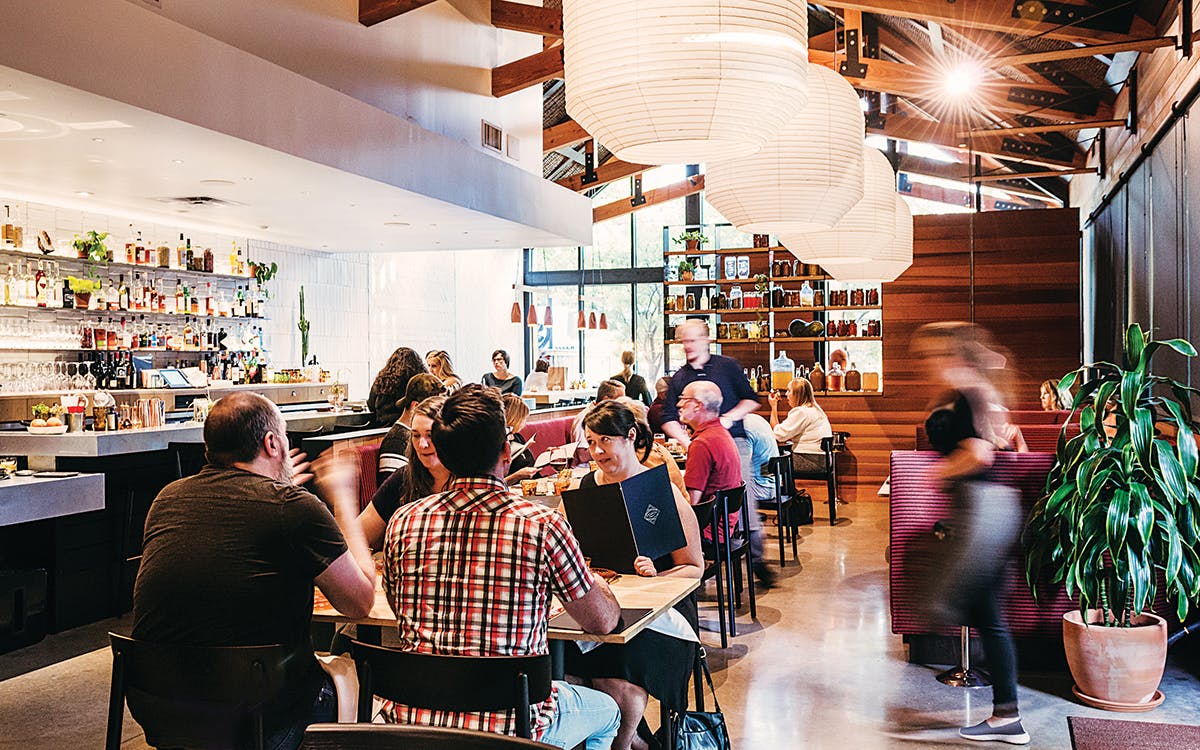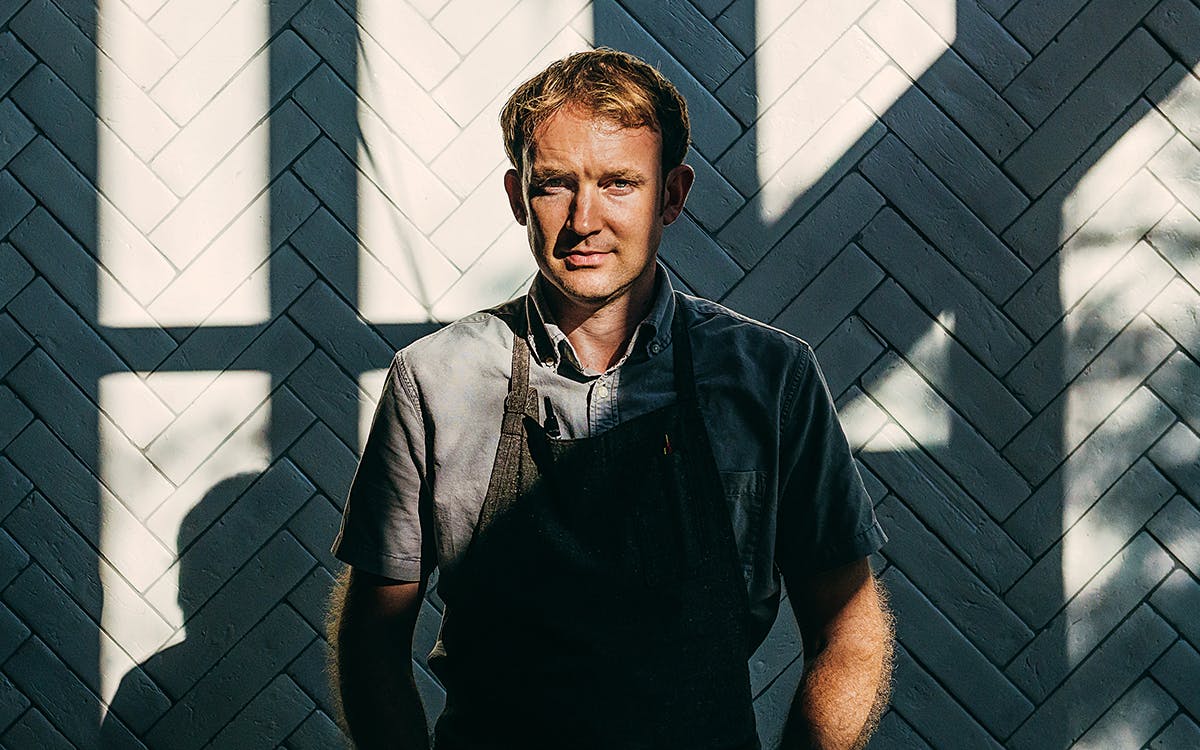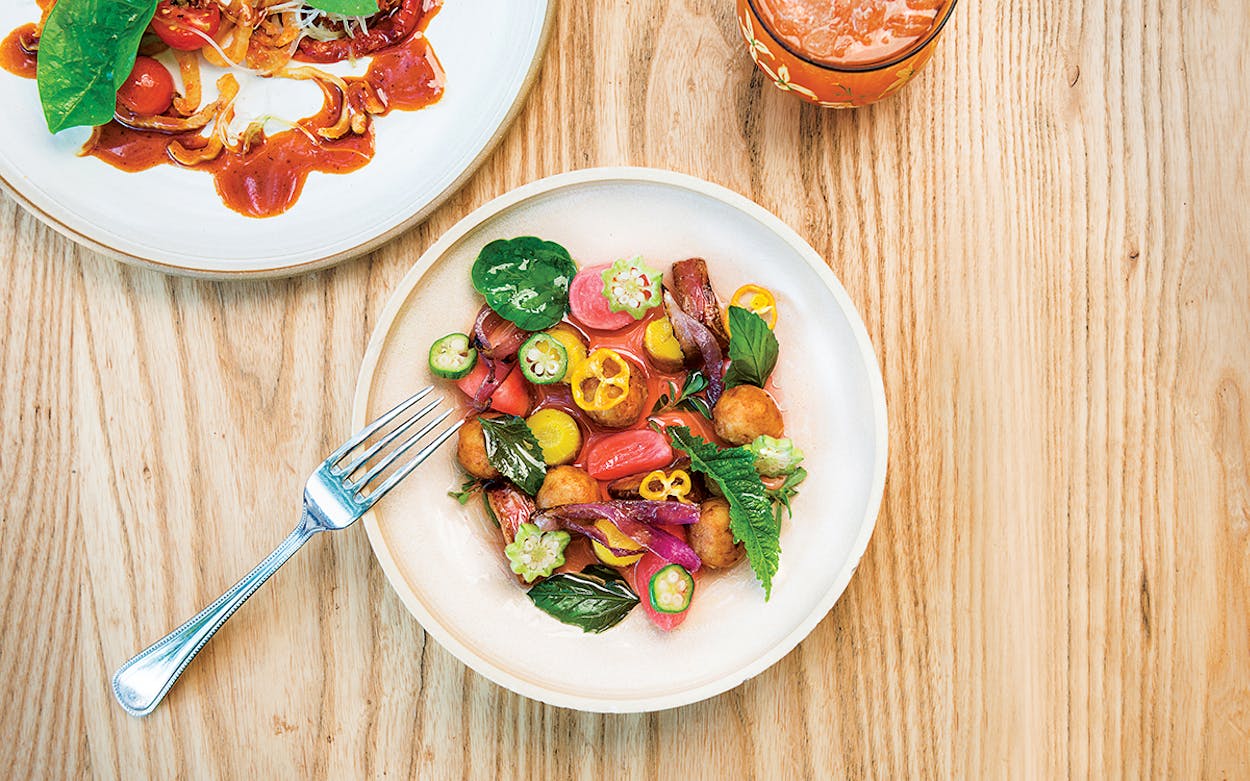This article appeared in the October 2017 issue of Texas Monthly with the headline “Not So Country After All.”
My nomination for the best single bite of the year is the quail egg shooter at Pitchfork Pretty. Gently shimmering, the translucent white oval comes nested on a bed of golden fried leeks in its own little ergonomic pottery dish. You tilt the vessel up, slurp the contents down, and hope your dining companion doesn’t notice you licking your lips afterward. For something that costs $3 and vanishes in three seconds, a lot of effort has been expended: the egg is perfectly poached, then pickled in a traditional dill brine; the leeks are crisp and salty-sweet. I’ve had dishes costing ten times as much that gave me ten times less pleasure.
Pitchfork Pretty opened in June, yet another in the cluster of impressive restaurants and bars in far east Austin. Occupying an architect-designed building with its own parking lot (yay!), it is a stylishly rustic structure with dark-stained timbers and lofty ceilings. Light floods through plate glass at the entrance and illuminates shelves of jars filled with house-made pickles and preserves, while white paper lanterns seem to float overhead. There’s a bar on the right-hand side where you can order from the full menu. I ran into a chef from a nearby restaurant eating there one night, checking out Pitchfork’s “Hill Country Cuisine,” and I couldn’t help wondering if he, like me, was puzzled by the folksy rubric. The design is considerably more sophisticated, and also more serious than the restaurant’s name, a catchy phrase that the owner dreamed up for his mom’s antiques shop but later reclaimed for his own pet project.

The two main forces behind this novel culinary endeavor are both Texans: the aforementioned owner, Seth Baas, who is 39, and chef Max Snyder, who is 36. Interestingly, Baas has more formal culinary education (he attended California Culinary Academy, in San Francisco). Snyder started out cooking at assorted greasy spoons (his words) as a teenager in Austin and then went on to work at Eleven Madison Park, in New York, and Coi and Saison, in San Francisco. It was in San Francisco, in fact, that the two met, while Snyder was cooking at Old Bus Tavern. Baas dropped in one night and immediately knew he had found a chef for the restaurant he wanted to open.
If Pitchfork Pretty’s polished design is at odds with its casual name, the same contrast is also true of its menu. I would put most of the dishes I tried on my first visit in the sophisticated category, chief among them the cheese-filled yuca dumplings with escabeche. To be honest, I was expecting a plate of fried dough balls with a vinegary dipping sauce. What arrived was a careful arrangement of fermented red radishes, teeny potatoes, and, yes, plump fried dumplings sitting in a tart coral-colored broth scattered with star-shaped okra slices. Inside each airy dumpling was a center of melty, mild Oaxaca cheese. It was original, to say the least, and I loved the interplay of unexpected textures and flavors. That outside-the-box sensibility extended to another small plate, a warm-and-cold salad of lightly grilled blue crab with broad, thin curls of celery and chunks of a fruity orange Charentais melon, which turned out to have been grown in Snyder’s garden. The spaetzle—those often-leaden egg-noodle dumplings—were another pleasant surprise. The best I’ve had in the past were light, white, and airy. The ones at Pitchfork were lean, green, and springy. Made with curly-leaf parsley, their herby flavor went beautifully with the accompanying broccolini and hen of the woods mushrooms and at the same time contrasted nicely with nibbles of bright green apple; somehow everything played well together, united by a sumptuous mustard seed–shallot cream sauce.
There are only three desserts on the menu, and the most creative is easy to spot: the multilayered, Instagram-ready crepe cake. It sounded intriguing, especially when our server explained that the crepes had been made with masa. The layers of icing were also Mexican: swaths of a fruity white-chocolate mole made with coconut milk. Sadly, though, it fell into the “sounded like a good idea at the time” category. If the kitchen hadn’t insisted on the grainy, stodgy masa, it might have worked better. As it was, a few bites sated my curiosity.

You could go to Pitchfork Pretty and do like I did at first: order everything that sounded strange and unusual. But you would miss some of the best things on the menu. Like the fried chicken. Snyder admits that he felt forced to include it: “Every restaurant needs things that are easy and recognizable.” But he didn’t want to do the same old same old. So he soaked the chicken in a vinegary-sweet pickled-habanero brine, then deep-fried it in a fluffy chickpea-flour batter. You can wolf the pieces down plain or dip them in a cool buttermilk dressing or a spicy Indonesian sambal.
A similar thing happens with another crowd-pleaser, the so-called barbecued chicken. The exterior of each bone-in piece was so darkly grilled it looked blackened, yet beneath the skin, the meat was supple. And if you peeked under one of those moist pieces, you would have found a lava flow of buttery mashed sweet potatoes. And that wouldn’t be all! You’d also encounter thick toasted country bread slathered with chicken-liver mousse. I readily admit it’s an odd combination (did I mention the grilled cabbage?), but I don’t know what I would leave out.
There are chefs whose gift is mastering the classics and coloring inside the lines, but Snyder is not one of those. He’s one of the fidgety types, whose talent is messing with tradition. More often than not, his flights of fancy work, which has led to him building up a fan base of novelty seekers—one of them being the chef from the nearby competing restaurant whom I’d spotted eating at the bar. Without even being asked, he told me, “The food is so good here!” I’ll bet he’ll be back to check out the next new thing. So will a bunch of people. So will I.
- More About:
- Pat’s Pick
- Austin









